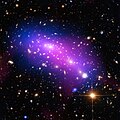File:A cosmic kaleidoscope.jpg

Original file (3,600 × 3,600 pixels, file size: 5.82 MB, MIME type: image/jpeg)
| This is a file from the Wikimedia Commons. Information from its description page there is shown below. Commons is a freely licensed media file repository. You can help. |
Summary
| DescriptionA cosmic kaleidoscope.jpg |
English: At first glance, this cosmic kaleidoscope of purple, blue and pink offers a strikingly beautiful — and serene — snapshot of the cosmos. However, this multi-coloured haze actually marks the site of two colliding galaxy clusters, forming a single object known as MACS J0416.1-2403 (or MACS J0416 for short).
MACS J0416 is located about 4.3 billion light-years from Earth, in the constellation of Eridanus. This new image of the cluster combines data from three different telescopes: the NASA/ESA Hubble Space Telescope (showing the galaxies and stars), the NASA Chandra X-ray Observatory (diffuse emission in blue), and the NRAO Jansky Very Large Array (diffuse emission in pink). Each telescope shows a different element of the cluster, allowing astronomers to study MACS J0416 in detail. As with all galaxy clusters, MACS J0416 contains a significant amount of dark matter, which leaves a detectable imprint in visible light by distorting the images of background galaxies. In this image, this dark matter appears to align well with the blue-hued hot gas, suggesting that the two clusters have not yet collided; if the clusters had already smashed into one another, the dark matter and gas would have separated. MACS J0416 also contains other features — such as a compact core of hot gas — that would likely have been disrupted had a collision already occurred. Together with five other galaxy clusters, MACS J0416 is playing a leading role in the Hubble Frontier Fields programme, for which this data was obtained. Owing to its huge mass, the cluster is in fact bending the light of background objects, acting as a magnifying lens. Astronomers can use this phenomenon to find galaxies that existed only hundreds of million years after the big bang. For more information on both Frontier Fields and the phenomenon of gravitational lensing, see Hubblecast 90: The final frontier. |
| Date | |
| Source | http://www.spacetelescope.org/images/potw1612a/ |
| Author |
NASA, ESA, CXC, NRAO/AUI/NSF, STScI, and G. Ogrean (Stanford University) Acknowledgment: NASA, ESA, and J. Lotz (STScI), and the HFF team |
Licensing
| ESA/Hubble images, videos and web texts are released by the ESA under the Creative Commons Attribution 4.0 International license and may on a non-exclusive basis be reproduced without fee provided they are clearly and visibly credited. Detailed conditions are below; see the ESA copyright statement for full information. For images created by NASA or on the hubblesite.org website, or for ESA/Hubble images on the esahubble.org site before 2009, use the {{PD-Hubble}} tag.
Conditions:
Notes:
|
- You are free:
- to share – to copy, distribute and transmit the work
- to remix – to adapt the work
- Under the following conditions:
- attribution – You must give appropriate credit, provide a link to the license, and indicate if changes were made. You may do so in any reasonable manner, but not in any way that suggests the licensor endorses you or your use.
Captions
Items portrayed in this file
depicts
21 March 2016
image/jpeg
5e4611959a2be86ac096ed271b7fc07f050eb956
6,106,268 byte
3,600 pixel
3,600 pixel
File history
Click on a date/time to view the file as it appeared at that time.
| Date/Time | Thumbnail | Dimensions | User | Comment | |
|---|---|---|---|---|---|
| current | 09:12, 31 December 2019 |  | 3,600 × 3,600 (5.82 MB) | BevinKacon | actual size from source |
| 23:43, 22 March 2016 |  | 1,280 × 1,280 (351 KB) | Jmencisom | User created page with UploadWizard |
File usage
The following 2 pages use this file:
Global file usage
The following other wikis use this file:
- Usage on es.wikipedia.org
- Usage on fr.wikipedia.org
- Usage on id.wikipedia.org
- Usage on ms.wikipedia.org
- Usage on www.wikidata.org
Metadata
This file contains additional information, probably added from the digital camera or scanner used to create or digitize it.
If the file has been modified from its original state, some details may not fully reflect the modified file.
| Author | Chandra X-ray Observatory Center |
|---|---|
| Copyright holder |
|
| Credit/Provider | NASA, ESA, CXC, NRAO/AUI/NSF, STScI, and G. Ogrean (Stanford University) Acknowledgment: NASA, ESA, and J. Lotz (STScI), and the HFF team |
| Source | ESA/Hubble |
| Usage terms |
|
| Short title |
|
| Image title |
|
| Date and time of data generation | 06:00, 21 March 2016 |
| Software used | Adobe Photoshop CS6 (Macintosh) |
| Copyright status | Copyright status not set |
| Unique ID of original document | xmp.did:046ddb8b-9647-8948-9d81-376405a18a3c |
| Keywords | MACS J0416.1-2403 |
| Contact information | cxcpub@cfa.harvard.edu
Karl-Schwarzschild-Strasse 2 Garching bei München, , D-85748 Germany |
| IIM version | 4 |


